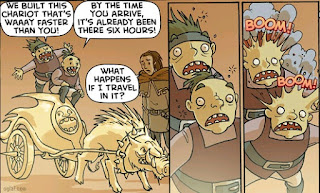This post was earlier cross-posted at Leonid Schneider's site. The version there is improved by Leonid's editing, frame-story, and additional background about Neandertal mini-brains.
.
A natural train of thought - the local commuter train, not the fast express service - leads us to Tochiyama et al. (2018), who recently compared the Neandertal and the Anatomically Modern Skull, to delineate the differences in shape and infer how this must have impacted on Neanderthal cognition. By "the Neandertal Skull" we mean four individual crania, each reassembled from fragments with state-of-the-art 'guesswork' methods to interpolate the missing bits; and the same for the four representatives of Cro-Magnon. Later steps in the


This explains the absence of frontal-lobe functioning among Mayans, other pre-Columbian cultures, East Germanic tribes, French peasants, and umpteen other groups known to modify their infants' cranial profiles with head-binding for aesthetic purposes and status enhancement.


Anyway... Tochiyama et al. are described as pioneers in this burgeoning new field of Quantified Neanderthal Phrenology:
But as SR co-author Naomichi Ogihara told Scientific American, they are the first to actually digitally reconstruct Neanderthal brains.The claim to precedence is true as long as one ignores a slightly-earlier and less-well-publicised study (Neubauer, Hublin and Gunz, 2018). Isn't it always the same? You wait for ages for a paper on Neandertal Phrenology and then two come along at once.
“Our method allows estimation of the shape and volume of each brain region, which is quite impossible just by analyzing the endocranial surfaces.”
Fig 1, Neubauer et al.
 In the Golden Age of craniometry in the early 1900s, skull-caliper hobbyists and gentlemen dilettante-anthropologists liked to divide populations into those with bradycephalic and dolichocephalic heads... long narrow heads (the latter kind) were more common in Europe, and therefore superior. But no-one argued that the owners of wider, brachycephalic skulls also possessed larger temporal lobes and would be more skilled in language, memory and facial recognition.*
In the Golden Age of craniometry in the early 1900s, skull-caliper hobbyists and gentlemen dilettante-anthropologists liked to divide populations into those with bradycephalic and dolichocephalic heads... long narrow heads (the latter kind) were more common in Europe, and therefore superior. But no-one argued that the owners of wider, brachycephalic skulls also possessed larger temporal lobes and would be more skilled in language, memory and facial recognition.*Now both studies fall within a recognised literary genre in which novelists and evolutionary psychologists and other authors of fiction speculate about the mental differences between Neanderthals and their anatomically-modern contemporaries, and about the racial-memory Original-Sin scars inflicted on the latter by the trauma of having to exterminate the former. Authors follow a roughly 30-year cycle, explaining the current revival of this literary tradition: see Wells 1921; Harness 1953; Golding 1955; Kurtén 1978; Auel 1980.**
 It goes without saying that Neandertals must have differed in some respect, for they are no longer extant and there must be some reason for this. Also no-one wants to miss an opportunity to talk about ourselves and 'human nature' in the guise of talking about what we are not. If Neanderthals had not existed then it would be necessary to invent them.
It goes without saying that Neandertals must have differed in some respect, for they are no longer extant and there must be some reason for this. Also no-one wants to miss an opportunity to talk about ourselves and 'human nature' in the guise of talking about what we are not. If Neanderthals had not existed then it would be necessary to invent them.Avid Riddled readers (is there any other kind?) will recall the beginning of this revival with the 'visual brain' theory from 2013. In this, evolution assigned so much of the Neandertal cortex to processing visual information (in compensation for the lower level of lighting in their Northern European habitat of icecaps and blizzards and cave-bears) that no brain-power was left for social-cognition skills and they could not cooperate in groups. Larger eye-sockets were adduced as evidence, and explained as an adaptation to capture more photons. This is SCIENCE so evidence is not merely 'provided' or 'tabled', it is adduced.
It is a very silly theory even by the relaxed standards of Riddled, and I can only suppose that it was accepted into Proc. Roy. Soc. B because the third author was Dunbar (of the eponymous Number). Some people might think that if Neanderthals had enlarged light-trap tarsier eyes, this would do away with the need for special night-sight neural processing requiring half their cortex... but those people are the same nay-saying skeptics and cavilling pedants who also point out that Neandertals lived all across the Levant and were not exclusively adapted to Northern Europe (that's just where a lot of caves are where their bones turned up), so their opinions can safely be ignored.
Press-release-regurging science churnalists at the time dwelt on the elongation of the Neanderthal side of the comparison:
And in fact, Neanderthal skulls suggest that the extinct hominids had elongated regions in the back of their brains, called the "Neanderthal bun," where the visual cortex lies.Here at the Riddled Institute of Impure Science and Gratuitous Innuendo, we attribute this cerebral elongation to the extreme rapidity of the Paleolithic forms of transport favoured by Neandertals (or perhaps they practiced head-binding), but other scholars are slow to accept this explanation.
"It looks like a Victorian lady's head," Dunbar told LiveScience.
Neubauer et al. (2018) went along with the elongation / globular narrative to account for Cro-Magnon ascendancy. In contrast, Tochiyama et al. (2018) (returning to them at last!) struck off in a new direction. Unable to find any convincing cerebral differences between their Neanderthal and Cro-Magnon reconstructions, they kept fishing, and eventually reported that modern brains have larger cerebellums. Or cerebella, as the case may be. This in turn led them to the startling conclusion that the cerebellum, previously regarded as responsible for 'muscle sequencing / coordination' computations for routine movements, must in fact be the centre of our highest cognitive qualities. I am not making this up:
A new scientific analysis shows that human skulls are shaped in a way that suggests they encased brains with slightly larger cerebellums than Neanderthals. The cerebellum is a brain region associated with activities like planning, adapting to new environments, switching between tasks, and building social relationshipsThis is the point where the usual pedants and critics object that the volume and neural density of the cerebellum also tend to be greater in men than in women. "Which probably means: Neanderthals were as unorganized, antisocial, unimaginative, multi-task failures as modern-day womenfolk!"
And because cerebellar volume is linked to abilities like cognitive flexibility, language processing, and working memory capacity, the scientists argue larger cerebellar hemispheres may have helped humans survive and adapt to a dangerous world while Neanderthals could not.
After all that, it is a relief to turn to a recent paper with a different approach to the question of Neandertal craniometry: Gregory et al. (2017) introduced the useful concept of the "NeanderScore" and reconstructed that prototypal skull shape by measuring living people and ranking them by their proportion of Neanderthal ancestry. High NeanderScorers tended to have bigger brains, especially at the back in an "occipito-parieto-temporal patch", and were especially endowed in the region of the intraparietal sulcus (perhaps best described as important for visual-motor skills).
Figure 2. NeanderScore related brain changes in the intraparietal sulcus. Structural variation of the intraparietal sulcus (IPS) related to percentage of Neanderthal-derived SNPs (NeanderScore). Left and middle show lateral and posterior views of the right IPS on the average brain surface, illustrating the anatomical convergence of the associations of NeanderScore with greater sulcal depth (orange; p < 0.05 FWE-corrected), gray matter volume (blue; p < 0.005), and white matter volume (yellow; p < 0.005).
There was no downside:It should be noted that we did not find associations of NeanderScore with smaller frontotemporal volumes38 or shortened anterior extension of the temporal lobes13, as might have been hypothesized from previous cranial analyses of H. neanderthalensisThe most recent, best-founded reconstructions of Neandertal appearance have an uncanny resemblance to Paula Modersohn-Becker's portraits of herself and husband Otto. Not that there's anything wrong with that.
Thanks to Tom Björklund for permission;
more of his work here
more of his work here
** There is also Vendramini's provocative idea that Neandertals were superior predators while their anatomically-normal contemporaries were merely prey to be stalked and consumed. This provides a possible explanation for the extinction of the Cro-Magnons. As for Kurup and Kurup's audacious but not particularly coherent notions about the autistic Neanderthal civilisation of Dravidian Lemuria, the less said the better.
*** Going back to the 'Automotive brain'... Oglaf's Dwarves demonstrated the effect of chariot speed on skull shape.
In our continuing experiments at Riddled, travel velocity has so far proved unpromising as a way of restructuring heads and brains, but that may simply reflect the fact that the fastest modes of transport accessible to the Riddled staff are the #23 bus, and Another Kiwi's pizza-delivery motortrike on days when he is not rostered on.
 We are naturally interested in any technology that lends itself to cranial ductility and cortical remodelling... especially after that experiment with the Cosmic Ray Concentrator that was supposed to increase Space-Time Eddie's cerebral capacity (or at least to shrink his body).
We are naturally interested in any technology that lends itself to cranial ductility and cortical remodelling... especially after that experiment with the Cosmic Ray Concentrator that was supposed to increase Space-Time Eddie's cerebral capacity (or at least to shrink his body).Suffice to say that the side-effects were undesirable.
















No comments:
Post a Comment